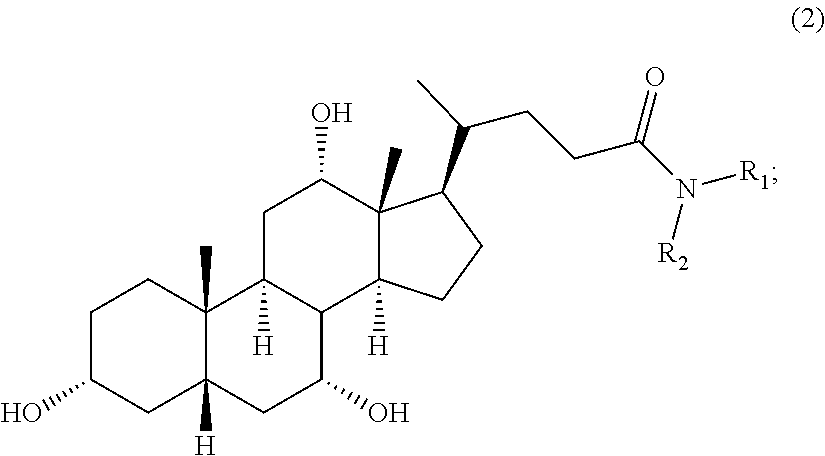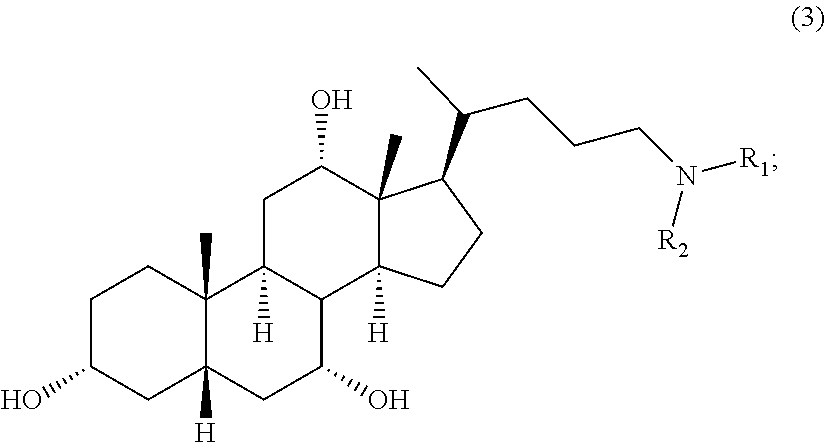Methods for the synthesis of ceragenins
a technology of ceragenin and ceragenin, which is applied in the field of making cationic steroidal antimicrobials, can solve the problems of peptide-based therapeutics that are not suitable for clinical use, the susceptibility of peptides to proteases generated by the host and by bacterial pathogens
- Summary
- Abstract
- Description
- Claims
- Application Information
AI Technical Summary
Benefits of technology
Problems solved by technology
Method used
Image
Examples
example 1
Preparation of CSA-54
Step 1: Preparation of Octylamide 47
[0124]
[0125]To a 5 L Round Bottom Flask equipped with an overhead mechanical stirrer, addition funnel, thermocouple and inert gas inlet was charged cholic acid (181.7 g, 445 mmole, 1.0 eq), HOBt (3.00 g, 22.2 mmole, 0.05 eq.), EDCI (93.9 g, 490 mmole, 1.1 eq) and DMAc (450 mL). Agitation was begun and N-methylmorpholine (113 g, 1.113 mole, 2.5 eq.) was added, followed by n-octylamine (69.0 g, 534 mmole, 1.2 eq.), added over about 45 minutes, keeping the temperature of the reaction mixture between 15-25° C. during the addition. The reaction mixture was then stirred under nitrogen for 60-64 hours.
[0126]The mixture was then diluted with 2-MeTHF (1.59 L) and cooled to 10° C. The reaction was quenched by addition of 3M HCl (0.68 L, 170 mL of 37% HCl required) over approximately 35 minutes, keeping the temperature of the mixture below 30° C. during the addition. The mixture was stirred for an additional 15 minutes then the contents ...
example 2
Preparation of CSA-61
Step 1: Preparation of Compound 57 from Cholic Acid
[0151]
[0152]To cholic acid (14.2 g) and 2-MeTHF (115 mL) was added octylbenzylamine 56 (7.63 g) and then DIPEA (7.1 mL). HATU (13.6 g) was then added and the slurry was aged at RT for an hour and then warmed to 50 C overnight. Slowly added 3M HCl (50 mL) with ice bath cooling and cut the layers. The organic layer was washed sequentially with water (2×100 mL), sodium bicarbonate (8 wt %, 50 mL) and water (50 mL). The organic layer was concentrated to a foam, then azeotropically dried with toluene (150 mL) on the rotovap. A total of 25 g of octylbenzylamine 57 as a thick oil (21 g theoretical) was obtained upon evaporation. Due to the syrupy nature of the triol, it is more convenient to keep as a toluene solution and use directly in the next step.
Step 1a: Preparation of Octylbenzylamine 56
[0153]
[0154]In a 2 L flask with an overhead stirrer, nitrogen line and thermocouple was added methanol (540 mL) and benzaldehyd...
example 3
Preparation of CSA-192
[0163]
Compound 1
[0164]Cholic acid (2.0 g, 4.8 mmol), EDCI (920.2 mg, 4.8 mmol), HOBt (648.6 mg, 4.8 mmol) were combined, followed by addition of THF (40 mL). The mixture was stirred at room temperature for 30 min. Octyl amine (1.4 mL, 5.76 mmol) was added dropwise. The reaction maintained at room temperature for 10 h. A one to one mixture of hexanes and ethyl acetate (100 mL) and water (50 mL) were added. The organic layer was washed with 4 M aqueous HCl (3×50 mL), 20% aqueous NaOH (3×50 mL), and brine (50 mL), dried over anhydrous Na2SO4, and concentrated to give 2.6 g of a white solid (86% yield).
Compound 2
[0165]N-octylcholamide (1) (1.7 g, 2.8 mmol) and KHMDS (2.8 g, 14 mmol) were combined, followed by addition of TFH (20 mL). The mixture was stirred at room temperature for 30 min and then cooled to 3° C. Allyl bromide (1.21 mL, 14 mmol) was added dropwise, and the mixture was allowed to warm to room temperature. After 30 min, hexane (20 mL) was added, and t...
PUM
| Property | Measurement | Unit |
|---|---|---|
| temperature | aaaaa | aaaaa |
| temperature | aaaaa | aaaaa |
| temperature | aaaaa | aaaaa |
Abstract
Description
Claims
Application Information
 Login to View More
Login to View More - R&D
- Intellectual Property
- Life Sciences
- Materials
- Tech Scout
- Unparalleled Data Quality
- Higher Quality Content
- 60% Fewer Hallucinations
Browse by: Latest US Patents, China's latest patents, Technical Efficacy Thesaurus, Application Domain, Technology Topic, Popular Technical Reports.
© 2025 PatSnap. All rights reserved.Legal|Privacy policy|Modern Slavery Act Transparency Statement|Sitemap|About US| Contact US: help@patsnap.com



